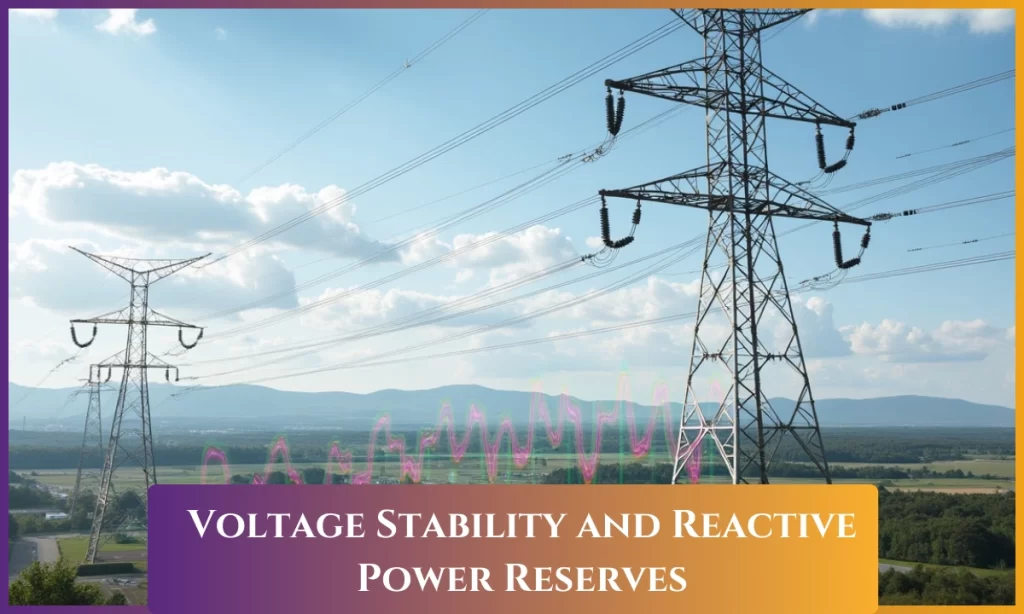Voltage stability is a critical aspect of power system reliability. It ensures that the grid’s voltage levels remain stable under varying load conditions. A lack of voltage stability can result in voltage drops and widespread power outages, jeopardizing the reliability of the electrical network.
Reactive energy storage plays a crucial role in stabilizing voltage by compensating for the system’s reactive power demand.
Reactive power reserves are sourced from generators, capacitors, Battery Energy Storage Systems (BESS), and other equipment. Maintaining a balance in reactive power is vital for ensuring grid stability and reliability. Optimizing these reserves is essential to preventing interruptions in the power supply and ensuring effective management of modern electrical systems.
How Voltage Stability is Influenced by Reactive Power Reserves
Reactive Power and Voltage Control:
- Reactive power supports voltage levels by compensating for inductive loads.
- Insufficient reactive power leads to voltage drops and system instability.
Effect of Load Changes:
- High loads increase the demand for reactive power, making reserves critical to stability.
- Fluctuating loads, especially in industrial and residential areas, stress voltage stability without adequate backup.
The Role of Transmission Lines:
- Long-distance power transmission causes reactive power losses.
- Voltage stability depends on the availability of local reactive power replenishment.
Involvement of Generators:
- Synchronous generators provide reactive power but have operational limits. Exceeding these limits can compromise voltage stability.
Failure Situations:
- Insufficient reactive power reserves can lead to voltage drops, power outages, and severe disruptions in power supply.
Applications and Benefits of Maintaining Reactive Power Reserves
Applications:
- Industrial Networks: Ensures stability in factories with high reactive power demands.
- Renewable Energy Integration: Manages fluctuations in reactive power from solar and wind sources.
- Urban Electrical Systems: Maintains stable voltage levels in densely populated areas.
- Emergency Scenarios: Assists grid recovery after power outages.
Benefits:
- Enhanced Grid Stability: Prevents voltage drops and power outages.
- Improved Power Quality: Reduces equipment wear and ensures consistent voltage levels.
- Increased Energy Efficiency: Minimizes energy transmission and distribution losses.
- Operational Flexibility: Enables the grid to dynamically respond to load changes.
Q Sine Energy: Optimizing Voltage Stability with Reactive Power Solutions
Q Sine Energy is a leader in providing innovative solutions for managing reactive energy storage and enhancing voltage stability.
The company offers advanced compensation systems, including Static VAR Compensators (SVC), to maintain voltage levels across diverse electrical grids. These systems are engineered to control fluctuating loads in industrial, commercial, and renewable energy applications.
With a focus on energy efficiency, Q Sine Energy provides diagnostic tools and customized solutions to address specific voltage stability challenges, ensuring optimal reactive power balance and robust grid performance.
Conclusion
Voltage stability and reactive energy storage are fundamental to the reliable operation of modern power systems. Without adequate reactive power reserves, the risks of voltage drops and widespread outages increase significantly.
Reactive energy storage ensures consistent voltage control, enhances power quality, and improves grid efficiency. Companies like Q Sine Energy are at the forefront of addressing these challenges through innovative solutions and advanced technologies.
By prioritizing voltage stability, the electrical network can meet growing energy demands, support the integration of renewable energy sources, and pave the way for a sustainable and reliable energy future.

